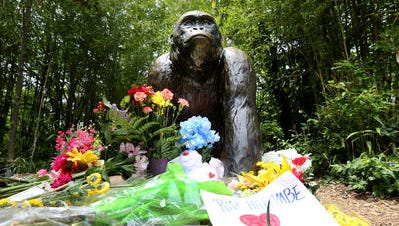Report faults zoo's gorilla barrier in Harambe case

CINCINNATI — The barrier separating primates and humans inside the Cincinnati Zoo was just fine — right up until the moment a child fell into the gorilla exhibit May 28.
That's the takeaway of a new federal report that concluded the zoo's barrier was not in compliance with standards for housing primates when a 3-year-old boy made international news by scaling a fence and falling 15 feet into a moat. That fall allowed Harambe, a 17-year-old gorilla, to reach the child and drag him around, ultimately forcing zoo officials to fatally shoot the primate.
The report, from the U.S. Department of Agriculture, issued a critical citation because the barrier failed and caused an animal to be harmed. Before the child fell into the exhibit, however, the zoo had not been cited for shortcomings with that exhibit's barrier during previous inspections.
In short, it's a complicated way of saying that everything would have been fine at the zoo had a child not fallen into the gorilla exhibit, but because one did, the barrier failed.
Cincinnati Zoo returns to Twitter after Harambe outrage
"Up until May 28, there hadn't been any issues, so they were in compliance," USDA spokeswoman Tanya Espinosa said. "It's ultimately their responsibility to make sure that their barrier restricts contact between the public and non-human primates."
The zoo so far doesn't face fines or penalties, but an investigation is still ongoing. Espinosa said zoo officials "swiftly and comprehensively" updated the barrier following the gorilla's death, which meant it was once again in compliance with federal standards.
The federal standards for primate barriers are vague. They don't specify height, materials or other physical characteristics. The only requirement is that they keep humans and animals apart.
The report goes on to state that the zoo's dangerous-animal response team followed proper procedures after zoo visitors called 911 to report a child in the gorilla enclosure.
A team member concluded that the child was in "life-threatening danger," and Harambe was killed.
Gail Myers, a spokeswomen for the family of the boy who entered the enclosure, said that the family has never wanted to pursue legal action against the zoo.
"These findings do not change anything for us. We are thankful to the Lord that our child is safe and well," the family said in a statement Thursday. "It was a tragic accident. We very much appreciate the quick actions by the Cincinnati Zoo staff, and mourn with them the loss of Harambe."
According to Enquirer reporting in June, the USDA has issued 10 citations in the last three years during inspections at the zoo. But most were minor, and none were at Gorilla World.
The USDA is tasked with enforcing the Animal Welfare Act, a portion of which governs the humane care and treatment of animals that are exhibited to the public. Facilities that exhibit regulated animals must be licensed by the USDA.
In response to the report, Cincinnati Zoo officials reiterated that about 43 million visitors in the past 40 years have gone through Gorilla World without coming into contact with gorillas.
Zoo gorilla Harambe shot and killed after boy falls into his enclosure
"The Cincinnati Zoo reaffirms its long-standing commitment to the well-being of the resident animals and the safety of those inspired to view and conserve them," a statement from the zoo said Thursday. "In its 38-year history, the barrier system at Gorilla World has always been found compliant during USDA inspections, including one conducted in April of 2016. Following the incident this May, we modified the barrier to reassure the public and our visitors."
Gorilla World was closed for 10 days following the incident in May. During that time, the zoo installed a new barrier railing. It is 42 inches high, with solid wood beams at the top and on the bottom, as well as knotted rope netting.
Contributing: Cameron Knight and Carol Motsinger, The Cincinnati Enquirer; The Associated Press